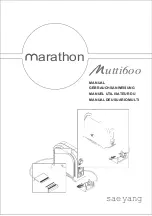
GB
| Operating Instruction
Attention: Noise protection! Please observe
the local regulations when operating your de-
vice
Intended use
Hints for your work with the tool
The
grass shears
allow for clean cuts of lawn
edges or hardly accessible lawn areas.
Each type of use other than those given in
these instructions for use can damage the
machine and cause serious risk to the user.
Please always observe the safety instructions
in order to safeguard your guarantee claim
and in the interests of product safety. Due to
the machine’s design, we are unable to fully
exclude all residual risks.
Residual dangers
Residual risks always remain even if the hedge
trimmer is used properly. The hedge trimmer‘s
design can entail the following hazards:
• Contact can be made with the unprotected
blade (resulting in cutting injuries)
• Reaching into or grabbing the hedge trim-
mer while it is in operation (resulting in cut-
ting injuries)
• Unanticipated, sudden movement of the
plant material being cut (resulting in cutting
injuries)
• Ejection or catapulting of damaged cutting
teeth
• Ejection or catapulting of the plant material
being cut
•
Hearing damage if the specified hearing
protection is not worn
• Inhalation of cut materials
General safety instructions
Attention!
Read all instructions contained
herein. Failure to observe the following
instructions may result in electric shock, burns
and/or severe injury. The term ‘power tool’
used in the following includes both mains-
operated tools (with mains supply) and
battery-operated tools (without mains supply).
KEEP THESE INSTRUCTIONS CAREFULLY!
1) Working area
a) Keep your working area clean and tidy.
Untidy and poorly lit working areas
may lead to accidents.
b) Do not operate the tool in potentially
explosive environments containing
combustible fluids, gases or dusts.
Power tools generate sparks that may
ignite dusts or fumes.
c) Keep children and other persons away
when you are operating the power
tool.
Distractions may result in the opera-
tor loosing control over the tool.
2) Electrical safety
a) The mains plug of the power tool must
fit into the mains socket. The plug
must not be modified in any way. Do
not use adapter plugs/connectors in
combination with tools with protective
earthing.
Unmodified plugs and fitting
sockets reduce the risk of electric shock.
b) Avoid physical contact with earthed
surfaces as pipes, heaters, ovens and
refrigerators.
There is an increased risk
of electric shock if your body earthed.
c) Keep the tool out of the rain.
The
penetration of water into a power tool
increases the risk of electric shock.
d) Do not use the cable to carry or hang
up the tool or to pull the plug out of
the socket. Keep the cable away from
heat, oil and sharp edges or moving
parts of the tool.
Damaged or tangled
cables increase the risk of electric
shock.
e) When operating a power tool out-
doors, use exclusively extension ca-
bles that are approved for outdoor-
use.
The use of an extension cable that is
suitable for outdoor use reduces the risk
of electric shock.
3) Personal safety
a) Always pay attention to what you do
and apply reasonable care when work-
ing with a power tool. Do not use the
tool when you are tired or under the
influence of medication, drugs or alco
-
GB-3
















































